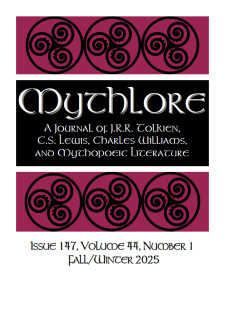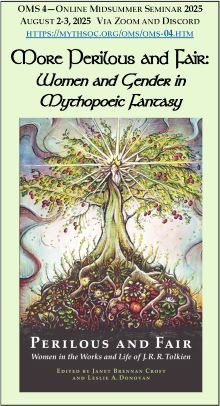Mythlore is a scholarly, peer-reviewed journal published by the Mythopoeic Society that focuses on the works of J.R.R. Tolkien, C.S. Lewis, Charles Williams, and the genres of myth and fantasy.
THE HISTORY OF MYTHLORE
Mythlore was founded in 1969 by the late Glen GoodKnight, Founder of the Mythopoeic Society. He edited its first 84 issues, with the exception of issues 18–23, which were edited by Gracia Fay Ellwood. In its early years, Mythlore was a “fanzine” that, in addition to scholarly articles, columns, and book and media reviews, included a great deal of art work, poetry, and other creative work. Over the years, the articles became more and more exclusively scholarly, and the creative work and fiction reviews moved to sister publications like Mythprint and Mythic Circle. When Dr. Theodore Sherman of Middle Tennessee State University assumed the editorship with issue #85 in 1999, Mythlore completed its transformation into a refereed scholarly journal publishing only articles and reviews. At that time, its format also changed from 8½” x 11” to 6½” x 9”. Janet Brennan Croft, currently of the University of Northern Iowa, became editor in 2006 and switched to a double-issue format with issue #93/94. The journal was published in two double issues per year, in approximately April and November through Spring 2013. In Fall 2013 the double issue numbering was dropped starting with issue #123, and electronic subscriptions became available for individuals.
Current Issue: Volume 44, Number 1 (Fall 2025, #147) (2025)
Editorial Introduction
Articles
“Desirable Lady” or “She Who Desires”: Examining Aredhel’s Agency in Tolkien’s Legendarium
Lyra Keran Zhang
Unknowing in Tolkien's Legendarium and the Agnosia of the Elvish Tradition
Benjamin Blakeslee-Drain
Literary Tributaries: Classical and Romantic Influences in The Wind in the Willows
Landon Burgess Loftin
Eleanor Arnason’s Fantastic Mitochondrial Humor
Sandra J. Lindow
Notes and Letters
Tolkien's Invasion of Dragons
Ian Gunn
Credit Where Credit’s Due: Douglass Parker and J.S. Ryan
Matthew Thompson-Handell
Tolkien’s Exceptional Visit to Holland, Revisited: An Acquaintance with Maartje Draak
Bart Jaski and Kris Swank
But I Made You Look: Mysticism, Desire, and the Refusal of the Literal
Züleyha Çetiner-Öktem
Book Reviews
Once Upon a Place: Forests, Caverns & Other Places of Transformation in Myths, Fairy Tales & Film by Holly Bellebuono
Isabella Martins-Simonsen
Historical Dictionary of Horror Literature, edited by Mark A. Fabrizi
Douglas A. Anderson
Nordic Sagas as Children’s Literature: Victorian and Edwardian Retellings in Words and Pictures by Velma Bourgeois Richmond
Maria K. Alberto

Editor
- Janet Brennan Croft, University of Northern Iowa
- Phillip Fitzsimmons, Administrator of Mythlore and Society Archives, Southwestern Oklahoma State University
- John Rosegrant
- Verlyn Flieger, University of Maryland, College Park
- Charles Huttar, Hope College
- Kris Swank, Signum University
- Rev. John W. Houghton, The Hill School, Pottstown
- Douglas A. Anderson, Independent Scholar
- Donna R. White, Arkansas Tech University
- Christopher Vaccaro, University of Vermont
- Robin Anne Reid, Independent Scholar
- James Prothero, Independent Scholar


